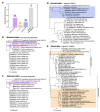A Novel Rubi-Like Virus in the Pacific Electric Ray (Tetronarce californica) Reveals the Complex Evolutionary History of the Matonaviridae
- PMID: 33807136
- PMCID: PMC8067182
- DOI: 10.3390/v13040585
A Novel Rubi-Like Virus in the Pacific Electric Ray (Tetronarce californica) Reveals the Complex Evolutionary History of the Matonaviridae
Abstract
Rubella virus (RuV) is the causative agent of rubella ("German measles") and remains a global health concern. Until recently, RuV was the only known member of the genus Rubivirus and the only virus species classified within the Matonaviridae family of positive-sense RNA viruses. Recently, two new rubella-like matonaviruses, Rustrela virus and Ruhugu virus, have been identified in several mammalian species, along with more divergent viruses in fish and reptiles. To screen for the presence of additional novel rubella-like viruses, we mined published transcriptome data using genome sequences from Rubella, Rustrela, and Ruhugu viruses as baits. From this, we identified a novel rubella-like virus in a transcriptome of Tetronarce californica-order Torpediniformes (Pacific electric ray)-that is more closely related to mammalian Rustrela virus than to the divergent fish matonavirus and indicative of a complex pattern of cross-species virus transmission. Analysis of host reads confirmed that the sample analysed was indeed from a Pacific electric ray, and two other viruses identified in this animal, from the Arenaviridae and Reoviridae, grouped with other fish viruses. These findings indicate that the evolutionary history of the Matonaviridae is more complex than previously thought and highlights the vast number of viruses that remain undiscovered.
Keywords: Arenaviridae; Matonaviridae; Reoviridae; fish; metatranscriptomics; phylogeny; rubella; ruhugu; rustrela; virus discovery; virus evolution.
Conflict of interest statement
The funders had no role in the design of the study; in the collection, analyses, or interpretation of data; in the writing of the manuscript, or in the decision to publish the results.
Figures


References
Publication types
MeSH terms
LinkOut - more resources
Full Text Sources
Other Literature Sources
Molecular Biology Databases

